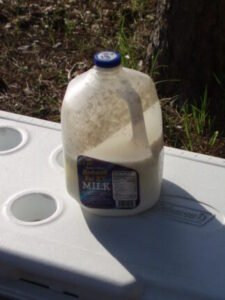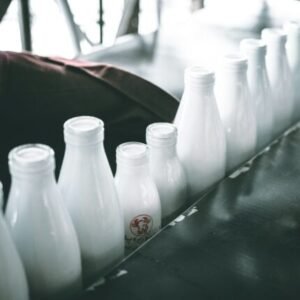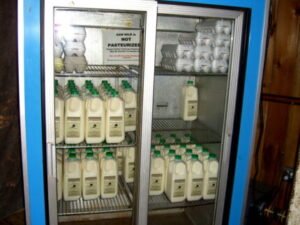Medically reviewed by Dr. Ramesh Gaddam, M.D. — Written by Sumalatha, D.N.H.E
Raw milk is milk that has not undergone any heat treatment or pasteurization to kill harmful bacteria and pathogens.
It is milk that comes directly from the cow, goat, sheep, or other mammals without being subjected to processes like pasteurization or homogenization. Raw milk is essentially untreated and unprocessed in terms of heat.
Benefits of Raw Milk
Proponents of raw milk claim various potential benefits, suggesting that it may offer nutritional advantages compared to pasteurized milk.
It’s important to note that while raw milk enthusiasts highlight these potential benefits, health experts and authorities, including the U.S. Centers for Disease Control and Prevention (CDC) and the Food and Drug Administration (FDA), caution against consuming raw milk due to the associated health risks.
The potential benefits often mentioned include:
- Nutrient Retention
- Probiotics
- Improved Allergies and Asthma
- Better Taste and Texture
Nutrient Retention:
Raw milk advocates argue that the heat used in pasteurization may destroy some of the beneficial nutrients present in milk, such as enzymes, vitamins, and beneficial bacteria. They claim that raw milk retains these nutrients in their natural state.
Probiotics:
Raw milk contains beneficial bacteria, enzymes, and probiotics that some believe can support digestive health and contribute to a healthy gut microbiome.
Improved Allergies and Asthma:
Some proponents suggest that raw milk consumption may reduce the risk of developing allergies and asthma, although scientific evidence supporting this claim is limited and inconsistent.
Better Taste and Texture:
Some individuals prefer the taste and texture of raw milk, finding it creamier and more flavorful compared to pasteurized milk.
Raw Milk Uses
Raw milk can be used in various culinary applications similarly to pasteurized milk. However, it’s important to be aware of the potential health risks associated with consuming raw milk, and individuals should follow food safety guidelines and regulations in their region. Here are some common uses for raw milk:
Drinking:
Some individuals choose to drink raw milk as is, appreciating its natural taste and potential nutritional benefits. However, this comes with the associated risks of bacterial contamination, so caution is advised.
Cheese Making:
Raw milk is often used in traditional cheese-making processes. Certain artisanal and specialty cheeses are made with raw milk to preserve the natural enzymes and bacteria that contribute to the cheese’s unique flavor and texture.
Yogurt and Fermented Dairy Products:
Raw milk can be used to make yogurt, kefir, and other fermented dairy products. The natural bacteria present in raw milk can contribute to the fermentation process.
Butter:
Raw milk can be used to make butter. The cream is separated from the milk and then churned to produce butter. Some people prefer the taste of raw milk butter.
Ice Cream:
Raw milk can be used as a base for homemade ice cream. The creaminess and natural flavors of raw milk may contribute to a rich and flavorful ice cream.
Hot Beverages:
Raw milk can be used in hot beverages like coffee, tea, and hot chocolate. Some individuals prefer the taste of raw milk in these beverages.
Baking:
Raw milk can be used in various baking recipes that call for milk. It can be used to make bread, cakes, muffins, and other baked goods.
Raw Milk Side Effects
Consuming raw milk comes with potential health risks due to the presence of harmful bacteria, such as E. coli, Salmonella, Listeria, and Campylobacter. These bacteria can cause foodborne illnesses, which can lead to serious health consequences. Here are some potential side effects and risks associated with drinking raw milk:
- Foodborne Illnesses
- Increased Vulnerability
- Infections
- Potential for Outbreaks
- Legal and Regulatory Issues
Foodborne Illnesses:
Raw milk can be contaminated with bacteria that cause foodborne illnesses. Symptoms of these illnesses may include diarrhea, abdominal cramps, vomiting, fever, and in severe cases, complications like kidney failure or death.

Increased Vulnerability:
Certain populations, such as pregnant women, young children, elderly individuals, and those with weakened immune systems, are more susceptible to severe complications from foodborne illnesses. For these groups, the risks associated with consuming raw milk are particularly high.
Infections:
In addition to gastrointestinal symptoms, consuming raw milk contaminated with specific bacteria, like Listeria, can lead to infections that affect other parts of the body, such as the bloodstream or the central nervous system.
Potential for Outbreaks:
Drinking raw milk can contribute to outbreaks of foodborne illnesses within communities. Contaminated raw milk can result in multiple cases of illness among those who consume it.
Legal and Regulatory Issues:
In many places, the sale and distribution of raw milk are regulated or prohibited due to the associated health risks. Consuming raw milk from unregulated sources increases the likelihood of exposure to harmful bacteria.
Caution:
It’s important to note that pasteurization, the process of heating milk to kill harmful bacteria, is a widely accepted and effective method for ensuring the safety of milk and dairy products.
Health authorities, including the U.S. Centers for Disease Control and Prevention (CDC) and the Food and Drug Administration (FDA), strongly advise against consuming raw milk due to the potential health risks.
If you are considering consuming raw milk or using it in any culinary applications, it’s crucial to be aware of the associated risks, source the milk from a reputable and legal supplier, and adhere to food safety guidelines.
Consultation with healthcare professionals is also advisable, especially for individuals in vulnerable populations.
Raw milk vs pasteurized milk
Comparison between raw milk and pasteurized milk :

| Characteristic | Raw Milk | Pasteurized Milk |
|---|---|---|
| Processing Method | Not pasteurized; untreated and unheated | Pasteurized; heated to kill bacteria |
| Microbial Content | Contains natural bacteria, enzymes, and probiotics | Bacteria and pathogens are eliminated during pasteurization |
| Nutrient Retention | Some proponents claim higher nutrient retention due to lack of heat treatment | May lose some heat-sensitive nutrients during pasteurization |
| Safety | Increased risk of harmful bacteria such as E. coli, Salmonella, and Listeria | Reduced risk of harmful bacteria, making it safer for consumption |
| Shelf Life | Shorter shelf life due to the absence of pasteurization | Longer shelf life due to pasteurization |
| Legal Status | Sale and distribution may be regulated or prohibited in some regions | Widely accepted and regulated, available in most markets |
| Recommended Population | Caution advised, especially for vulnerable populations (pregnant women, young children, elderly, and those with weakened immune systems) | Generally considered safe for the general population |
| Taste and Texture | Some people prefer the taste and creaminess of raw milk | May have a different taste and texture due to pasteurization |
| Availability | Limited availability; depends on local regulations | Widely available in grocery stores and markets |
Conclusion:
It’s important to note that the decision to consume raw or pasteurized milk depends on individual preferences, health considerations, and local regulations.
While some people appreciate the potential benefits of raw milk, health authorities typically recommend pasteurized milk as a safer option for reducing the risk of foodborne illnesses.
Individuals should carefully consider the potential risks and benefits and make informed choices based on their health status and local regulations.
Taste of Raw Milk
The taste of raw milk can vary depending on several factors, including the source of the milk, the diet of the animals, and individual preferences. Here are some general characteristics of the taste of raw milk:
Creaminess:
Raw milk is often described as creamier compared to pasteurized milk. This is due to the presence of natural fats and lipids that are not affected by the heat used in pasteurization.
Freshness:
Raw milk enthusiasts often appreciate the “fresh” and “natural” taste of raw milk. Some people describe it as having a more distinct and unaltered flavor compared to pasteurized milk.
Sweetness:
Raw milk is said to have a slightly sweeter taste than pasteurized milk. This sweetness is attributed to the natural sugars present in the milk.
Terroir Influence:
Similar to how wine enthusiasts talk about terroir, the taste of raw milk can be influenced by the environment in which the animals are raised. The type of grass, soil, and climate can contribute to the unique flavors in the milk.
Seasonal Variations:
The taste of raw milk can also vary seasonally. Changes in the diet of the animals, such as access to fresh pasture during certain times of the year, may influence the flavor of the milk.
Frequently Asked Questions
How to Make Butter from Raw Milk
Making butter from raw milk is a simple process. Here’s a basic method:
Separate Cream:
Allow raw milk to sit undisturbed in the refrigerator for several hours or overnight. The cream will rise to the top.
Skim Cream:
Skim off the cream layer using a spoon or a separator.
Churn Cream:
Place the cream in a jar or butter churn and shake vigorously or use a hand mixer until the butterfat separates from the liquid (buttermilk).
Drain and Rinse:
Drain the buttermilk and rinse the butter under cold water.
Salt (Optional):
Add salt to taste if desired.
How Long Is Raw Milk Good For
Raw milk is best consumed within 5 to 7 days when refrigerated at temperatures between 38°F to 40°F (3°C to 4°C).
How to Make Yogurt from Raw Milk
Making yogurt from raw milk involves heating and fermenting. Here’s a basic method:
Heat Milk:
Heat raw milk to around 180°F (82°C) to kill potential harmful bacteria.
Cool Milk:
Cool the milk to around 110°F (43°C).
Inoculate with Yogurt Culture:
Add a small amount of yogurt with live cultures as a starter.
Incubate:
Keep the milk at a consistent temperature (around 110°F) for several hours to allow the yogurt cultures to ferment.
Chill:
Once set, refrigerate the yogurt.
How Long Does Raw Milk Last in the Fridge
Raw milk can last for about 5 to 7 days when stored in the refrigerator at temperatures between 38°F to 40°F (3°C to 4°C).
How to Make Butter with Raw Milk
Refer to the steps outlined in “How to Make Butter from Raw Milk.”
How to Make Yogurt with Raw Milk
Refer to the steps outlined in “How to Make Yogurt from Raw Milk.”
How to Make Raw Milk Yogurt
Follow the steps outlined in “How to Make Yogurt from Raw Milk.”
How Long After Drinking Raw Milk Can You Get Sick
The onset of illness from drinking raw milk can vary, but symptoms may appear within hours to several days after consumption.
How Long Does Raw Milk Last in the Refrigerator
Raw milk typically lasts about 5 to 7 days in the refrigerator when stored at temperatures between 38°F to 40°F (3°C to 4°C).
What to Do with Raw Milk
Raw milk can be consumed directly, used to make various dairy products like butter, yogurt, and cheese, or incorporated into recipes like smoothies and desserts.
How to Make Cottage Cheese from Raw Milk
Making cottage cheese from raw milk involves curdling the milk, draining the whey, and seasoning the curds. Detailed recipes are available online.
How to Make Cheese from Raw Milk
Making cheese from raw milk involves curdling the milk, pressing and aging the curds. Specific steps depend on the type of cheese desired.
How to Make Cheese with Raw Milk
Refer to the steps outlined in “How to Make Cheese from Raw Milk.”
Raw Milk When Pregnant
Pregnant women are generally advised to avoid raw milk due to the risk of harmful bacteria. Pasteurized milk is a safer option during pregnancy.
How to Pasteurize Raw Milk
Pasteurizing raw milk involves heating it to a specific temperature for a set duration to kill harmful bacteria. Equipment and detailed procedures are available for home pasteurization.
How Much Protein in Raw Milk
The protein content in raw milk can vary but is generally around 8 grams per cup (244 grams).
Please note that these instructions are general guidelines, and specific methods may vary. Additionally, always follow proper food safety practices and adhere to local regulations regarding raw milk consumption.
Medically reviewed by Dr. Ramesh Gaddam, M.D.

General Physician, Diabetologist, and Critical Care Specialist.
Discover more from Health Build-Up
Subscribe to get the latest posts sent to your email.


